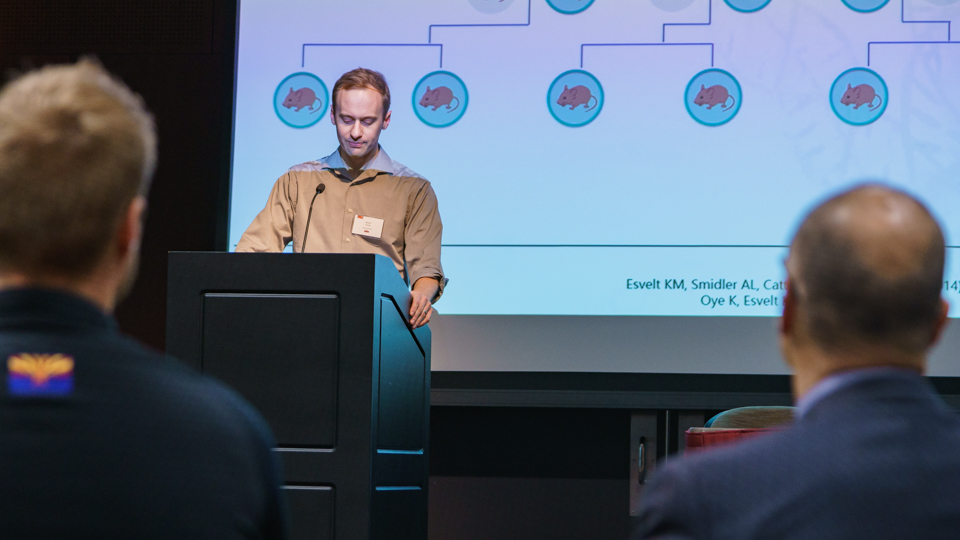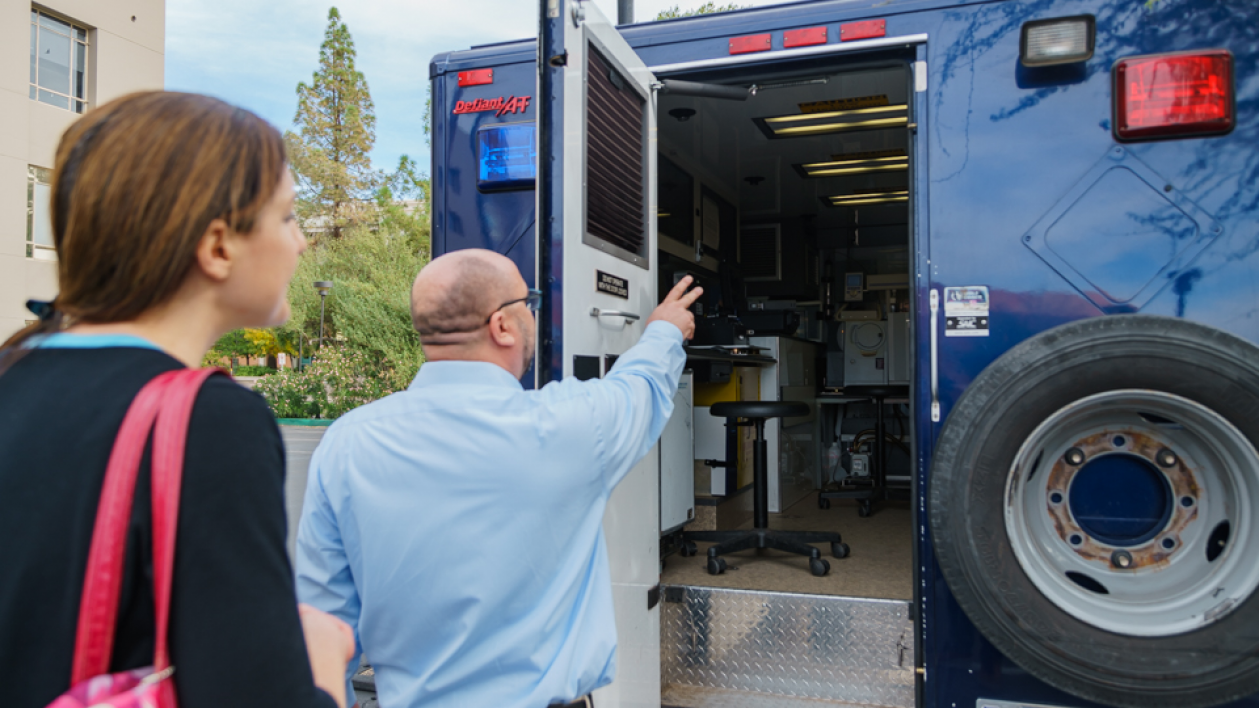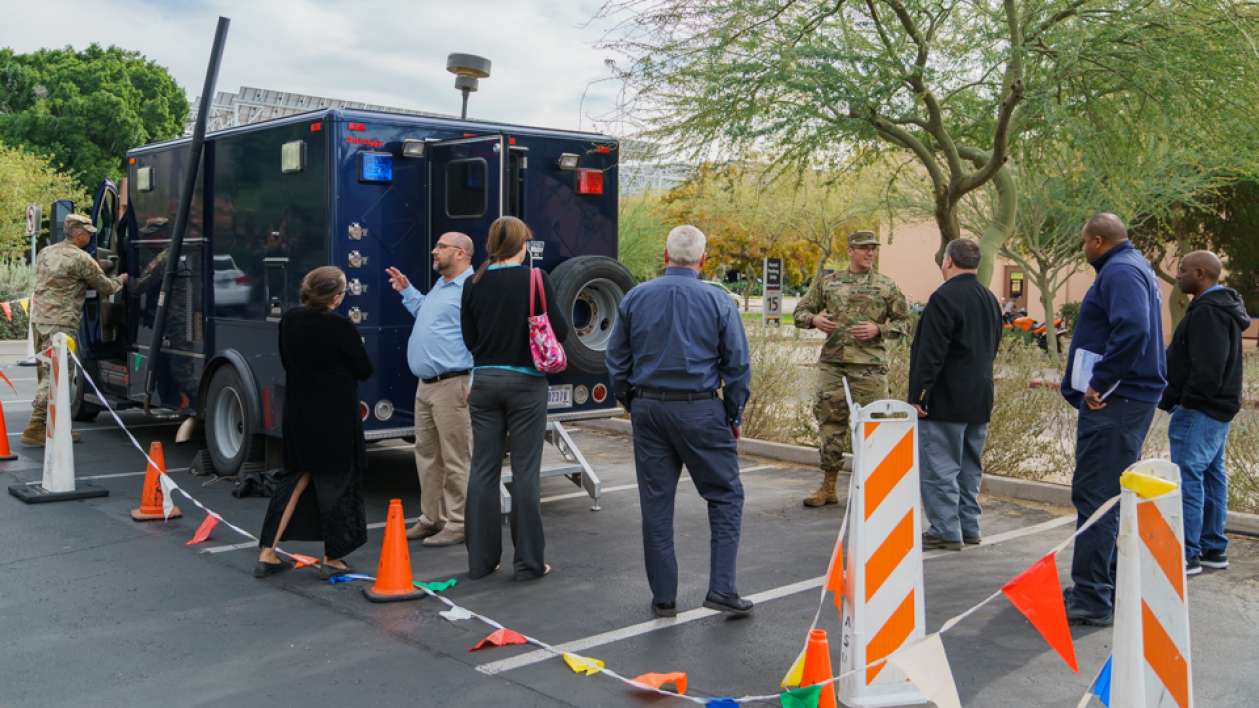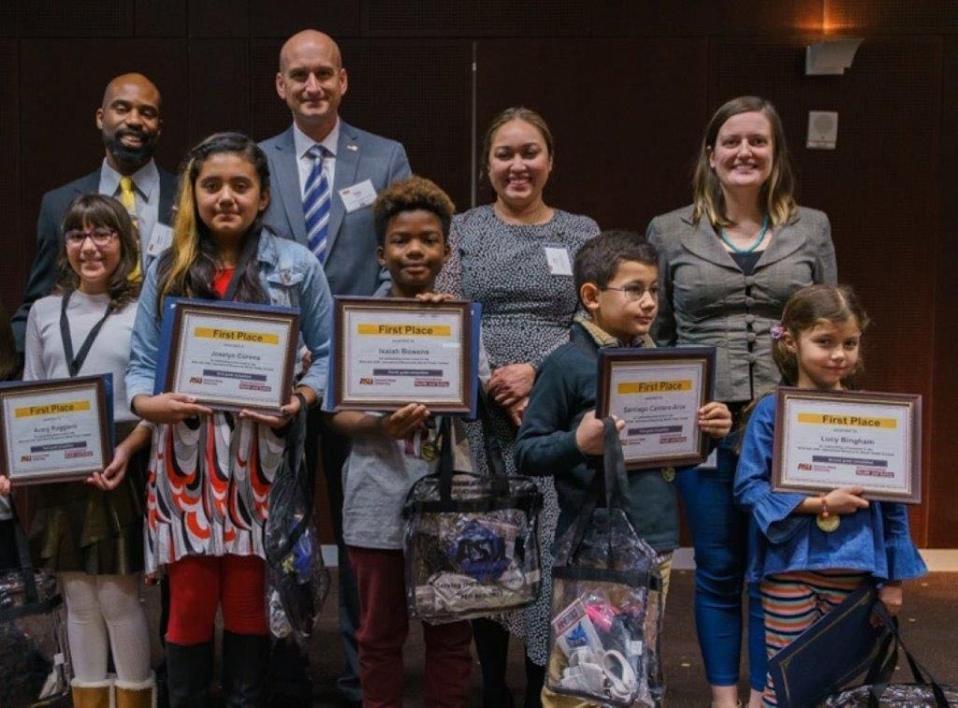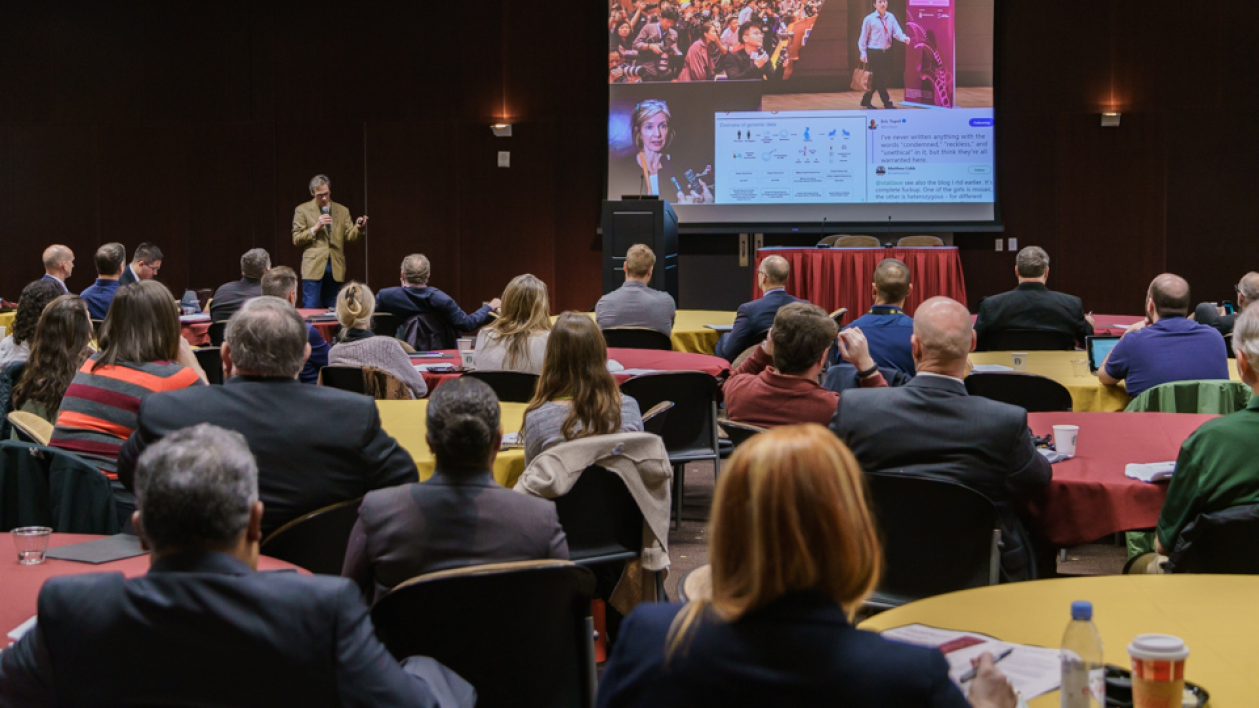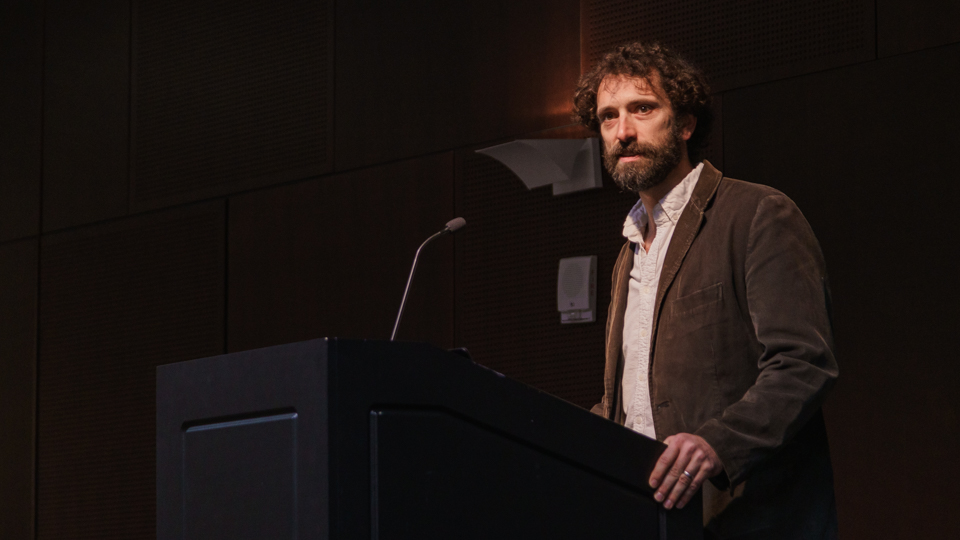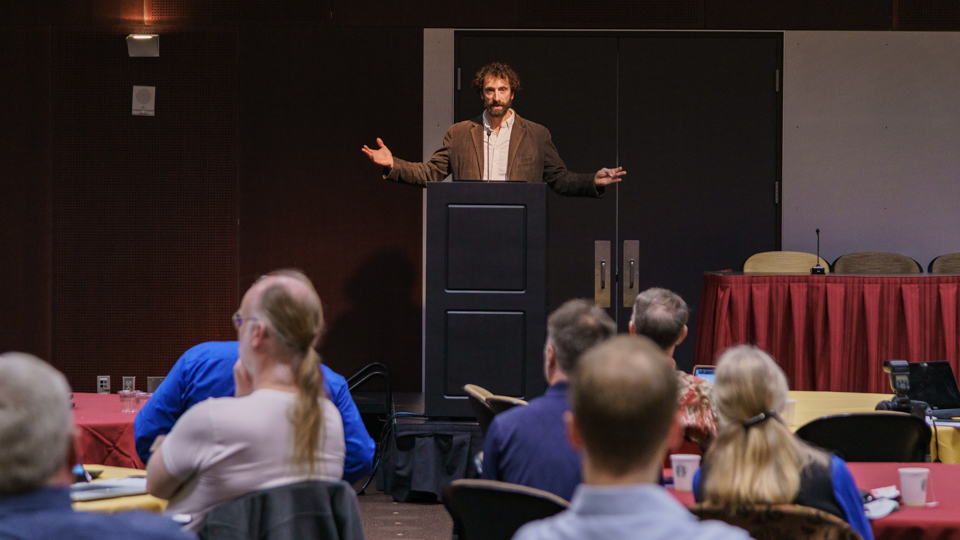Experts wrestle with today’s tough biotechnology questions at third Arizona Biosecurity Workshop

MIT Technology Review Senior Editor Antonio Regalado helped launch a furious debate about editing the human genome when he broke the story of China’s He Jiankui’s twin experiment. Present at the International Summit on Human Genome Editing, Regalado captured a photo of the researcher, upper right, briefcase in hand.
Given the enormous attention recently trained on a Chinese scientist who performed a gene-editing experiment on human twins, interest in scientific protocol, responsibility and biosecurity is at an all-time high. Attendance at the third annual Arizona Biosecurity Workshop, held at Arizona State University on Dec. 13 and 14, was certainly evidence of the fierce current debate.
At the event, the biggest questions revolved around the threats, opportunities and responsibilities tied to emerging technologies that have the potential to change human life and the environment dramatically. The conference engaged more than 200 representatives from academia, government, law enforcement, emergency response, industry and the interested public.
How do we predict and prepare for a future of rogue biological technology?
When do we contain knowledge? When do we share?
Who gets to decide what’s right and what’s wrong?
Fundamentally, the most important question among the biosecurity professionals at the conference was how to keep people safe.
CRISPR babies create an incredible sense of urgency
Antonio Regalado, senior editor of the MIT Technology Review and the journalist who broke the story on the effort to create the first genetically engineered babies in China, launched the workshop with his “up-close and personal” version of a story that took the world by storm.
“I think the CRISPR baby story is kind of a stand-in for other things we are worried about. It’s a test run,” Regalado said.
Regalado explained that there was a spectrum of opinion on the development of such technologies. For those strongly in support, we have both young people exploring CRISPR in their basements and wealthy individuals in Silicon Valley interested in replicating their own superiority, he said.
“(There) are the people I call ‘liberal eugenics or consumer eugenics' — people who are really enthusiastic about (the fact) ‘the genome isn’t perfect.'”
"On the other side of the spectrum, there are people who are opposed to this, people who say we should never genetically engineer humans. It’s a group that I call the bio-political left. They don’t like the idea of crossing the germ line. To them, that’s a threshold that shouldn’t be crossed. It’s a human rights issue. They don’t believe nature should be changed in that way.”
“In the middle is also emerging an argument in favor of the technology from doctors, notably George Daley, dean of Harvard Medical School, who has looked at situations where it could be useful or necessary to allow people to have children who are not affected by genetic disease,” said Regalado.
“Medical scientists are now in a fight to use this technology for the benefit of the people, similar to fights over anatomical research in the 19th century as well as the introduction of antiseptics,” he explained. “So, in that sense, gene editing could become a new medical cause in the same way that stem cell research has been in recent years.”
Bottom line, Regalado said that the experiment in China “appears to be a true disaster.”
“The technology wasn’t really ready for prime time,” he said.
J. Benjamin Hurlbut, an associate professor of bioethics in ASU’s School of Life Sciences, was in Hong Kong when Chinese researcher He Jiankui presented his work involving CRISPR technology to modify the two embryos to stop them from inheriting their father’s HIV. The project failed and set off a storm of controversy.
Hurlbut explained that there was a nearly palpable moment of judgment and “repudiation of He’s experiment as irresponsible,” and the researcher was marked “as having gone rogue.”
Keeping pace with unimaginable possibilities
“This year’s biosecurity workshop has highlighted the rate at which gene-editing technologies are being developed and used, which has brought an immediacy to the issues that are under discussion,” said James Collins, Virginia M. Ullman Professor of Natural History and the Environment at ASU. Collins is a leading voice in the questions and directions of genetic research.
“The pace of biotechnological development is about to get a gigantic upshift,” said Andrew Hessel, CEO of Humane Genomics Inc. “It will quickly trend faster and cheaper than it is today.” Hessel is a co-founder of Genome Project-write, the international scientific effort to engineer large genomes, including the human genome.
According to David Gillum, the workshop founder and ASU’s director of biosafety and biosecurity, the idea for convening began several years ago when the FBI introduced its academic biosecurity engagement program. Gillum’s interest led him to think: “Let’s begin with ASU.”
“The first year was mostly about biosecurity and the connections with Arizona-based life science industries, law enforcement and the surrounding communities. The next year we decided to further bridge the gap between underrepresented community members, the scientists doing the work and the experts discussing the technical and policy implications of the applied science. This year, we decided to take it even further and talk about game-changing biotechnologies that deserve a rich, thoughtful dialogue between experts and the public,” Gillum said.
The workshop is driving actionable results. Gillum and his colleagues at the American Biological Safety Association and AMEXBIO (Asociación Mexicana de Bioseguridad) are working to develop biosecurity knowledge and expertise.
“We are creating a biosecurity credential — an international standard regarding knowledge, ethics, testing and education,” Gillum said.
“I think that the conversations we have here are extremely important. It’s critical that we continue to have these conversations, so we keep biosecurity and biosafety a topic that everyone is thinking about,” said Bert Jacobs, chair of the ASU Institutional Biosafety Committee, a Biodesign Institute researcher and a professor in the School of Life Sciences.
He noted that, “at times, it can be both terrifying and exhilarating when you think about what we can do today. Each one of us has only one part of the answer. We have to include as broad a group of people as we can into these conversations.”
Experts from Stanford, Harvard, MIT, Merck, North Carolina State University, the Centers for Disease Control and Prevention and even a do-it-yourself community laboratory in Brooklyn, New York, provided a mosaic of musings regarding “where do we go from here?”
Who decides what’s right and wrong?
Ultimately, Hurlbut suggests that “we have to attend to the stories science tells about itself because they shape the ways we think and act. Who are the heroes? Who are the villains? And what are the stories that don’t get told about how researchers contend with uncertainty and ambivalence about the implications of their work?”
“We are faced with a global issue, and we need to develop the capacity to create a global dialogue,” said Gaymon Bennett, associate professor of religion, science and technology in the School of Historical, Philosophical and Religious Studies at ASU.
Perhaps one answer may come from an emerging project called “Code of the Wild: The Nature of Us, Edited,” a multimedia program led in part by Samira Kiani, assistant professor in the School of Biological and Health Systems Engineering in the Ira A. Fulton Schools of Engineering at Arizona State University. Kiani is partnering with Rhumbline Media and director Cody Sheehy “to explore diverse aspects of genome engineering including social, ethical and medical risks and benefits in future societies,” with the ultimate goal of creating a “conversation between the public and scientists, across all cultures, about how these technologies should be developed and used.”
At the same time, researcher Kevin Esvelt, assistant professor at the MIT Media Lab, cautioned researchers to use discretion.
“If something can be weaponized or cause harm, researchers should use caution,” he warned. “Ultimately, even brilliant and well-meaning scientists cannot reliably anticipate the consequences of their work.” His bottom line: “Suppose there exists at least one accessible advance whose discovery and dissemination would threaten civilization. The current research enterprise is highly likely to stumble on and disseminate it.”
Esvelt is an evolutionary and ecological engineer who is on a mission to prevent Lyme disease on Nantucket and Martha’s Vineyard, which have the second- and third-highest occurrences of tick-borne disease in the country. Esvelt’s approach “uses CRISPR to genetically modify white-footed mice which can carry Lyme in their blood and pass it on to biting ticks,” according to NOVA, which produced a profile on Esvelt and his work.
Of spies, espionage, cybercriminals, terrorist attacks and weapons of mass destruction
Though certainly top of mind, genetic editing isn’t the sole concern of biosecurity experts. Experts remain watchful for the emergence of biological pathogens and toxins, among other acts that threaten humanity.
“We have to work together to stay ahead of this,” said Phillip Bates, supervisory special agent, FBI-Phoenix. “If we want to be successful, we have to join hands and work together. When I say ‘protecting United States against terrorist attacks,’ that happens to be the FBI’s No. 1 priority. This includes preventing not just criminals, but terrorists from use of WMDs, chemicals, biological and nuclear materials.”
Bates explained that the FBI seeks to partner with the academic and research communities to improve awareness and report suspicious activities by research entities.
“But I want to make sure that I am crystal clear on this: The FBI is by no means trying to deter or impede innovation,” Bates said. “We are trying to protect everybody’s equities. We are trying to make people aware that there are people out there that are trying to steal valuable biological information and property.”
Catastrophes don’t respect borders
Luis Alberto Ochoa Carrera of the Ministry of Health in Mexico, who is also a founding member of the Mexico Biosafety Association, provided his perspective on the importance of biosafety internationally. He maintained that it is imperative that we make better use of our existing resources to guarantee safety and health for all.
“People are always trying to communicate and express their major concerns,” he said. “In my personal opinion, we are moving forward because we are now answering the unanswered questions that we had at the workshop last year. And maybe after this meeting ends, we will have more questions that will be answered in 2019.”
“I want to create better communication between individuals and institutions,” Ochoa explained. “It doesn’t matter whether we are talking about a government institution or a nonprofit organization. I want to have better communication, and I want to eliminate the language barriers, as well as the cultural differences as we move forward to the WHO (World Health Organization) concept of One Health.”
We are the world; we are the children
As young children and their parents began to approach the stage, the workshop ended with a dramatic reminder of what’s at stake in any discussion about biosecurity.
Title IV-A Arts Education Specialist for the Arizona Department of Education Haley Honeman expressed her support for the new program designed to raise the awareness and interest of young people in biosafety, biosecurity and STEM (science, technology, engineering and math) through artistic expression.
“As the world increases in its complexity, it’s important that we prepare our children to be imaginative thinkers to confront today’s challenges and tomorrow’s unimaginable situations with creativity and grace,” she said.
Arizona students were invited to participate in an art competition for the workshop. K–5 students were encouraged to illustrate their ideas on how to stop germs while students from sixth grade through high school shared their ideas on how biosafety can defend the Earth from germs.
The winners, 13 students from Phoenix and Mesa schools, were treated to a special luncheon at the workshop and were presented with a medal and a commemorative certificate for their participation. First-place winners won a $25 gift certificate to purchase STEM supplies for their school.
Bates addressed the group, saying, “It’s a passion of the FBI to see a wonderful future for the young people to educate yourself and be interested in STEM — we are excited about the next generation of leaders in the fields of science, technology, engineering and math.”
During the event, attendees were also treated to a tour of ASU’s Biodesign Institute buildings and a tour of a Biological Safety Level 3 (BSL-3) mobile lab staffed by the 91st Civil Support Team of Phoenix.
Arizona State University, the Federal Bureau of Investigation and the Arizona Biosafety Alliance cohosted the event.
More Law, journalism and politics

Annual John P. Frank Memorial Lecture enters its 26th year
Dahlia Lithwick, an MSNBC analyst and senior legal correspondent at Slate, is the featured speaker at the School of…

The politics behind picking a romantic partner
A new study reveals the role that politics play when picking out a romantic partner — particularly for older adults.“Findings…

Tips to make tax season less taxing
When it comes to highly unpleasant experiences, filing taxes is probably up there with root canals — which is why people put off…


